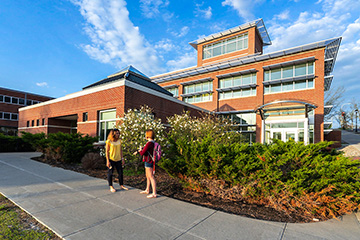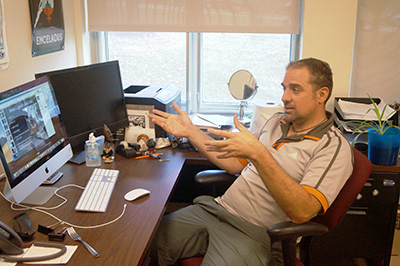
10/22/2020
SUNY Cortland professors are teaching during an unprecedented semester created by the COVID-19 pandemic. Through all of the challenges, faculty members have stayed dedicated to their craft in attempt to create meaningful experiences for their students. This profile continues a five-part series.
Jeremy Jimenez has relied on small group discussions and activities to supplement lectures throughout his teaching career. But social distancing guidelines forced him to replace those activities with a new approach to delivering important course content.
“It’s forced me to up my storytelling game,” said Jimenez, an assistant professor in the Foundations and Social Advocacy Department. Imagination and energy are crucial to keeping his students engaged.
His department prepares future teachers to work with learners of all abilities, and all of his current classes explore race, class and gender issues. Jimenez has been quick to discuss an important lesson of the pandemic: online learning can lead to greater inequity for school-aged children without technology resources, high-speed internet access or quiet study space.
But video platforms such as Zoom don’t have to be the only alternative to in-person instruction, he suggested. For example, this semester Jimenez asked students to walk through the Cortland Rural Cemetery near the university’s campus to observe ways that the historic site might reveal subtle differences in class and gender decades ago. He also assigned students to interview people who hold jobs that do not require college degrees, taking note of their struggles, triumphs, attitudes and beliefs.
 |
| Jeremy Jimenez, an assistant professor in the Foundations and Social Advocacy Department, leads a lesson from his office. |
“A lot of people think that if you’re not in person, you need to be online,” said Jimenez, suggesting that lived experiences and shared conversations can be more illuminating that sitting at a computer screen.
Admittedly, Jimenez often needs technology to connect with his SUNY Cortland students. When the pandemic halted in-person instruction in March, he turned to the text messaging platform GroupMe to keep class discussions going. Jimenez found it more inclusive, as students who were hesitant to speak in class joined the conversation. Plus students gained a thread where they could refer back later in the semester, using a popular smartphone app that doesn’t require strong bandwidth.
For several semesters, Jimenez also has used Twitter as a discussion platform to meet students through social media interaction. He points out the potential dangers of social media as they relate to disinformation, bullying, mental health and data privacy concerns. But he asks students to occasionally use Twitter as a way to share articles and discuss current class topics.
“As a teacher, you want to be in tune,” Jimenez said. “You want to dip your toe in the water that people immerse in … You want to be equipped with more direct understanding and awareness, while simultaneously being cognizant of the dangers of spending too much time using social media.”
Do you know a SUNY Cortland professor or student who has done something interesting in their classes during the pandemic? Email communications.office@cortland.edu